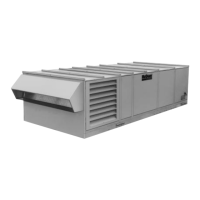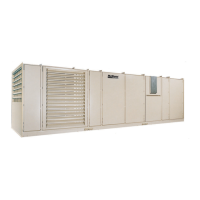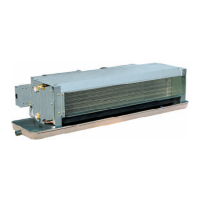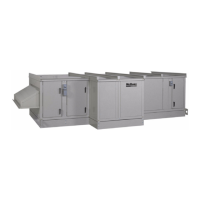Page 52 IM-738
drives the outdoor air dampers towards the open position,
and MCB-BO5 towards the closed (line 338). If the outdoor
air dampers are wide open and more cooling is required, the
dampers will hold their positions and mechanical cooling
will be activated (see below).
When the outdoor air is not suitable for free cooling, the
switch in enthalpy sensor OAE is in position "1", de-energiz-
ing binary input MCB-BI11 (Alternatively, the outdoor air
temperature is above the changeover setpoint plus the econo-
mizer changeover differential). When the economizer is dis-
abled, the dampers are held at their minimum position.
Mechanical Cooling Operation
4-Compressor/4 Stage Unit
Refer to “Typical Condensing Unit Control for RPS with
MicroTech II Control (4 Compressor Unit Shown. RCS has
minor variations)” on page 58 as you read this sequence of
operation. In this configuration there are 4 equally sized
compressors and two cooling circuits. In the following
description, compressor #1 is lead. However, if Auto Lead/
Lag Staging is selected on the keypad, the lead compressor
will be the one in the lead circuit with the least number of run
hours.
When the unit disconnect is closed, 115VAC power is sup-
plied directly from control transformer T1 to the compressor
crankcase heaters, HTR-1, 2, 3 & 4 (lines 825, 875, 823, 873)
and motor protectors MP1, 2, 3 & 4 (lines 826, 876, 824,
874). This same 115 VAC source also goes through:
1. System switch, S1 (line 205)
2. The optional phase voltage monitors, PVM1 & 2
(lines 205, 805)
3. The optional ground fault relays, GFR1 & 2
(lines 205, 805)
4. Compressor control switches, CSI & 2 (lines 828, 881)
5. Transformer T9 is also powered
Compressor control switches, CS1 & 2 also provide 24 VAC
from transformer T9 to compressor control boards CCB1 and
CCB2 (lines 811, 861) as well as the following cooling cir-
cuit binary inputs:
1. Frost protect FP1 to CCB1-BI8 (line 814) - Optional when
no hot gas bypass is ordered on the unit
2. Frost protect FP2 to CCB2-BI8 (line 864) - Optional when
no hot gas bypass is ordered on the unit
3. HP relay R1 to CCB1-BI7 (lines 815)
4. HP relay R2 to CCB2-BI7 (lines 865)
5. Compressor contactor status M1-AUX2 to CCB1-BI9
(line 816)
6. Compressor contactor status M2-AUX2 to CCB2-BI9
(line 866)
7. Compressor contactor status M3-AUX2 to CCB1-BI10
(line 817)
8. Compressor contactor status M4-AUX2 to CCB2-BI10
(line 867)
9. Unit pump down switch PS3 (lines 818)
10. Circuit pump down switch PS1 to CCB1-BI11(line 818)
11. Circuit pump down switch PS2 to CCB2-BI11(line 868)
12. Cool enable from MCB-B07 to CCB1-BI12 and CCB2-
BI12 (lines 820, 870)
When manual pumpdown switches PS1, PS2, and PS3 are
closed, all four compressors are fully enabled and ready to
start if commanded to by the MicroTech II control system.
Cross Circuit Loading
If cooling is enabled (MCB-BI3 is energized) and mechani-
cal cooling is required, the MCB will energize cool enable
output MCB-BO7 (lines 820) to binary inputs CCB1-BI12
(lines 820) and CCB2-BI12 (line 870). The MCB will also
send a digital communications signal to CCB1 & 2 to enable
cooling. CCB1-BO4 output will energize and open liquid line
solenoid valve SV1 (line 841), allowing refrigerant to flow
into the evaporator coil. As the refrigerant evaporates, the
suction pressure increases until low pressure switch LP1
closes (line 820) as a binary input to CCB1-BI6. When
CCB1 senses that LP1 has closed, CCB1-BO1 & BO5 will
energize contactors M1 and M11 (lines 827 and 842) to start
compressor #1 and condenser fan #11. (The above descrip-
tion applies to units without the low ambient start option, For
a description of low ambient start, see the "Unit Options"
section of this manual,) Additional condenser fan stages will
be added as the outdoor air temperature rises above setpoints
input through the keypad. CCB1-BO6 controls contactor
M12 (line 843), which cycles condenser fan 12. CCB1-BO7
controls contactor M13 (line 844), which cycles condenser
fan 13. This is stage 1.
If more cooling is required, CCB2-BO4 will energize and
open liquid line solenoid valve SV2 (line 891), allowing
refrigerant to flow into the evaporator coil. As the refrigerant
evaporates, the suction pressure increases until low pressure
switch LP2 closes (line 870) as a binary input to CCB2-BI6.
When CCB2 senses that LP2 has closed, CCB2-BO1 & BO5
will energize contactors M2 and M21 (lines 877 and 892) to
start compressor #2 and condenser fan #21. Additional con-
denser fan stages will be added as the outdoor air temperature
rises above setpoints input through the keypad. CCB2-BO6
controls contactor M22 (line 893), which cycles condenser
fan 22. CCB2-BO7 controls contactor M23 (line 894), which
cycles condenser fan 23. This is stage 2.
If more cooling is required, CCB1-BO2 will energize contac-
tor M3 (line 832) to start compressor #3. This is stage 3.
If more cooling is required, CCB2-BO2 will energize contac-
tor M4 (line 882) to start compressor #4. This is stage 4.
When the cooling demand is satisfied, MCB works through
CCB1 & 2 to stage down the compressors. If Auto Lead/Lag
Staging is selected, the compressor with the most hours will
stage off first and so on. When both circuits are running with
only one compressor each (stage 2) and less cooling is
required, if circuit #2 is lag, CCB2-BO4 de-energizes to
close liquid line solenoid valve SV2 (line 891). As a result,
compressor #2 pumps down refrigeration circuit #2 until the
suction pressure drops low enough to open low pressure con-
trol LP2 (line 870). When LP2 opens, CCB2-BO1, BO5,
(BO6 and BO7) will de-energize to shut down compressor #2
and its associated condenser fan(s).
When mechanical cooling is no longer necessary, CCB1-

